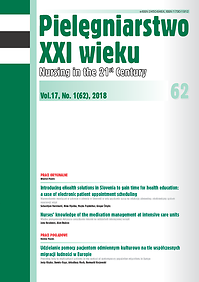Introducing eHealth solutions in Slovenia to gain time for health education: a case of electronic patient appointment schedulin
DOI:
https://doi.org/10.2478/pielxxiw-2018-0001Keywords:
eZdravje, eNaročanje, patient appointment scheduling, nurse, nursing, time burdenAbstract
INTRODUCING EHEALTH SOLUTIONS IN SLOVENIA TO GAIN TIME FOR HEALTH EDUCATION: A CASE OF ELECTRONIC PATIENT APPOINTMENT SCHEDULING
Introduction. Accelerated computerization of health systems begun in Slovenia in 2008 with the eZdravje (eHealth) project. Various aspects of the system enable patients to track different aspects of their health care more efficiently. The eNaročanje (eScheduling) part enables patients to be more actively integrated into the health services, as well as presents significant help for administrative work and more time for health education.
Aim. The aim of our research was to show which type of patient appointment scheduling is the least burdensome for nurses.
Material and methods. We used a quantitative research methodology. Collecting data took place in May 2017. We gathered the various patterns of scheduling patients for appointments in a single month at an outpatient care unit in the north-eastern region of Slovenia. We collected the data concerning the time needed to perform different patients’ appointment scheduling and we interpreted the data with the help of descriptive statistics.
Results and conclusion. Between January 2016 and January 2017 less than 1% of patients made appointments through eNaročanje. Since January 2017, when eNaročanje started in studied unit, the percentage of patients who made their appointments through eNaročanje increased, and by May 2017 there were 60 (20%) of the overall 298 patients in the study who used the system. We came to the conclusion that in the 17 workdays in May 2017 there were 126 (42%) appointments made by men and 172 (58%) by women. An average time spent personally or on the phone calls scheduling was significantly higher than the time spent through the eNaročanje service. We have shown that out of 17 workdays, the nurse spends more than an entire workday for the patient appointment scheduling tasks (8 hours,
13 minutes and 31 seconds). Information and communication based solutions can bring many advantages, especially regarding the time burden
challenges that the nurses currently face, optimization of administrative work as well as promoting health care through education of patients.
References
1. Žumer J. Website patient appointment scheduling: Diploma thesis. Kranj: Univerza v Mariboru: Fakulteta za organizacijske vede, 2011.
2. Menachemi N, Collum TH. Benefits and drawbacks of electronic health record systems. Risk Management and Healthcare Policy. 2011; 4: 47-55.
3. Coleman EW, Delea KC. The use of public health informatics to improve environmental health practice. Journal of Environmental Health. 2013; 5(76): 44-45.
4. Gibson PJ, Shah GH, Streichert LC, Verchick L. Urgent challenges for local public health informatics. Journal of Public Health Management and Practice. 2016; 6(22): S6-S8.
5. O’Neill B, Ziebland S, Valderas J, Lupiáñez Villanueva F. User-generated online health content: a survey of Internet users in the United Kingdom. Journal of Medical Internet Research. 2014, 4(16): e118.
6. Liddell A, Adshead S, Burgess E. Technology in the NHS. London: King’s Fundl; 2008.
7. Sedig K, Parsons P, Dittmer M, Ola O. Beyond information access: support for complex cognitive activities in public health informatics tools. Online Journal of Public Health Informatics. 2012; 3 (4), p. ojphi.v4i3.4270.
8. Hoyt RE. Health informatics - Practical Guide for Healthcare and Information Technology Professionals, 2014.
9. Kutney-Lee A, Kelly D. The effect of hospital electronic health record adoption on nurse-assessed quality of care and patient safety. The Journal of Nursing Administration. 2011, 11(41): 466-472.
10. van Gemert-Pijnen J, Nijland N, van Limburg M, et al. A holistic framework to improve the uptake and impact of eHealth technologies. Journal of Medical Internet Research. 2011; 4(13): e111.
11. Schwartz A. Nurses adopt electronic health records. 2012. [Online]. Available: https://scienceofcaring.ucsf.edu/patient-care/nurses-adopt-electronic-healthrecords. [Accessed 5 marec 2017].
12. Campanella P, Lovato E, Marone C, et al. The impact of electronic health records on healthcare quality: a systematic review and meta-analysis. European Journal of Public Health. 2015; 1(26): 60-64.
13. Bae J, Encinosa WE. National estimates of the impact of electronic health records on the workload of primary care physicians. BMC Health Services Research. 2016; 16: 172.
14. Vodicka E, Mejilla R, Ralston LSJ, et al. Online access to doctors’ notes: patient concerns about privacy. Journal of Medical Internet Research. 2013; 9(15): e208.
15. Kummervold PE, Chronaki CE, Lausen B, et al. eHealth Trends in Europe 2005-2007: a population-based Survey. Journal of Medical Internet Research. 2008; 4(10): e42.
16. Santana S, Lausen B, Bujnowska Fedak MCC, et al. Online communication between doctors and patients in Europe: status and perspectives. Journal of Medical Internet Research. 2010; 2(12): e20.
17. Kontis V, Bennett JE, Mathers CD, et al. Future life expectancy in 35 industrialised countries: projections with a Bayesian model ensemble. The Lancet. 2017; 10076(389): 1323-1335.
18. Kralj K. e-Scheduling – description of a solution, 4 12 2009. [Online]. Available: http://www.mz.gov.si/fileadmin/mz.gov.si/pageuploads/eZdravje/Strokovni_dialog/eNarocanje_01.pdf. [Accessed 3 March 2017].
19. Stanimirović D. Information systems and business-information architecture in Slovenian healthcare: theoretical and operational aspects and perspectives. Reprint ed., Ljubljana: Fakulteta za upravo, Univerza v Ljubljani, 2015.
20. Pišek T. Informatization of the health system: assessment of the situation in Slovenia and the possibility of introducing cloud computing: Master thesis, Ljubljana: Univerza v Ljubljani: Ekonomska fakulteta, 2014.
Published
Issue
Section
License
Copyright (c) 2018 Authors

This work is licensed under a Creative Commons Attribution-NonCommercial-NoDerivatives 3.0 Unported License.




